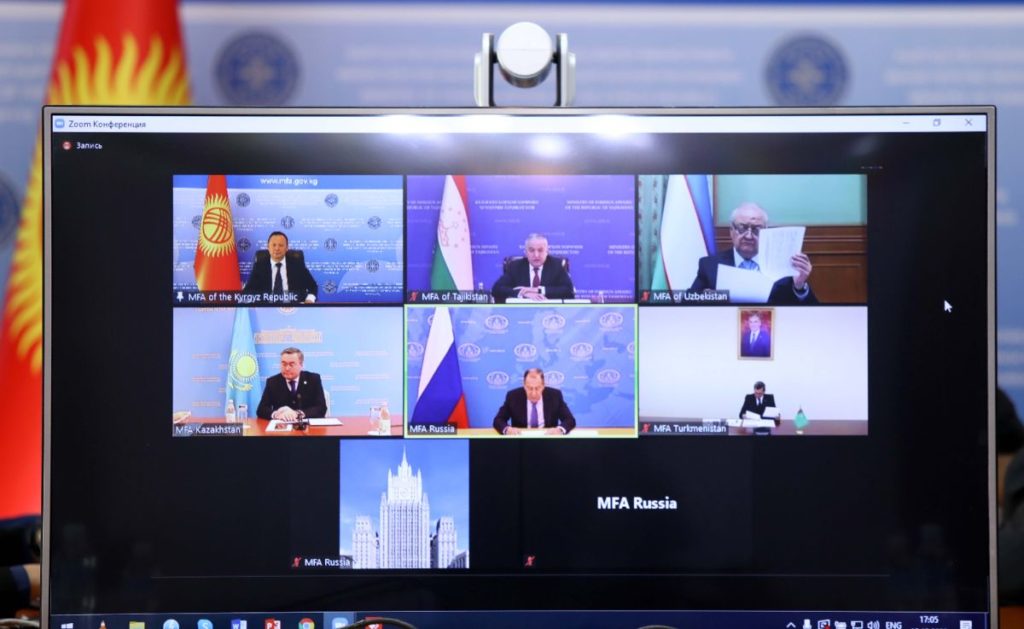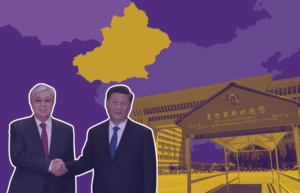Russia wants to intensify cooperation with Central Asia. During a video conference on 15 October, the foreign ministers of Russia and the Central Asian states adopted a declaration on cooperation. The main innovation is the establishment of the joint dialogue format “Central Asia + Russia”.
This article was originally published on Novastan’s German version.
The foreign ministers of Kazakhstan, Kyrgyzstan, Uzbekistan, Tajikistan, Turkmenistan and the Russian Federation met for a video conference on 15 October 2020. Although this was only the third meeting in the “Central Asia + Russia” format, the foreign ministers published the joint statement “On strategic directions for cooperation”. It states, among others, that this dialogue format should be continued and intensified.
Want more Central Asia in your inbox? Subscribe to our newsletter here.
This is a true innovation for Russia’s Central Asia politics. While the USA and European Union have long maintained their “C5+1 format”, Russia had so far limited itself to bilateral cooperation or cooperation within the framework of international alliances. These include the Eurasian Economic Union (EAEU) and the Collective Security Treaty Organisation (CSTO). EAEU members are Russia, Armenia, Belarus, Kazakhstan and Kyrgyzstan, while Uzbekistan has observer status. The CSTO comprises the five EAEU members and Tajikistan.
Cooperation on COVID-19, but not only
According to the press release of the Russian Ministry of Foreign Affairs, the meeting focused on cooperation in the fight against the COVID-19 pandemic. While this is also reflected in the joint statement of the foreign ministers, this issue is included in a wide range of other fields of cooperation. These include security policy, economy, transport, migration, environment and the energy sector.
Yet, in many areas, the concrete form of cooperation remains vague. For example, the section on migration states that “it seems important to take concrete steps to create the most favourable conditions for the life and work of migrant workers from individual Central Asian countries”, but does not specify these steps in detail.
With regard to the environment, problems such as water pollution and glacier melt are mentioned by name. Yet the document does not specify to what extent Russia, which has recently barely been unable to cope with environmental disasters on its own territory, may help with these problems.
Concerning economics, the document highlights several successes to date. Russia is already one of the most important investors in Central Asian economies and the trade balance impresses with its volume of more than 30 billion US-Dollars in 2019. It is roughly the same as the trade balance between Central Asia and the European Union. The partners intend to intensify this cooperation. Joint projects are also planned in the energy sector by exchanging scientific findings and improving technologies. In addition, cooperation is planned for the training of specialists.
There is a clear common interest in the section on transport, as both Russia and the Central Asian countries are transit countries for goods between Europe and Asia. “We note that we are willing to work together to address the structural and institutional challenges … to reduce transit and trade costs, increase competitiveness and improve market access for other countries”, the declaration states. Russia’s willingness to cooperate in this field was demonstrated most recently in September when it became known that Moscow wants to be involved in the construction of the China-Kyrgyzstan-Uzbekistan railway corridor.
Cooperation on security policy is of particular interest. As the Russian daily newspaper Kommersant points out, the countries promise not to take any steps that could endanger the partners’ interests and cause confrontation. Yet such a conflict of interests could arise if, for example, Central Asian countries made their airspace available for the military needs of other powers. The USA, in particular, recently discussed with Kazakhstan and Uzbekistan the possibility of transit flights through their airspace. In addition, Russia is offering assistance to counter threats emanating from Afghan territory, such as terrorism, drug trafficking and arms smuggling.
A strike against the USA?
Kommersant reported that although the declaration was drafted in Moscow, it was subsequently discussed and revised with all states involved. “The result is a document that meets the interests of all parties involved, not just an external player, which distinguishes it from American or European strategy”, the Russian media notes, pointing out that a similar American document mentions “democracy” five times and “human rights” four times.
In February, the United States presented its diplomatic programme for Central Asia for the years 2019-2025. The document, entitled “Advancing Sovereignty and Economic Prosperity”, sets out the US government’s priorities in the region. These include support for the independence and sovereignty of the region’s states, respect for human rights, the fight against terrorism, but also US investments in the Central Asian economies.
At the time, Russia sharply criticised the American strategy. “Unfortunately, our American colleagues believe that they can do anything they want and at the same time make their partners turn away from Russia and probably also from China”, Russia’s foreign minister Sergei Lavrov told the Russian agency TASS. Western commentators, on the other hand, criticised the lack of innovation in the American strategy and the lack of resources for its implementation.
The new approaches in Russia’s Central Asia policy and the agreements made in the joint declaration could well contribute to consolidating Russia’s role in Central Asia. Russia would however have to follow up the declaration with concrete action. “It is clear that the declaratory strategy is just a document, and that reality is much more complex”, Kommersant concludes.
Whether the new strategy will allow Russia to push back other global political actors in the region remains an open question, especially as the Central Asian states have refrained from binding themselves to one partner. Aside from that, the USA is certainly not Russia’s main competitor for hegemony in Central Asia, but rather China is.
Robin Roth
Editor of Novastan Deutsch
Translated from German by Nora Heinonen
 Russia tries new diplomatic approach with “Central Asia + Russia” format
Russia tries new diplomatic approach with “Central Asia + Russia” format 



